The Impact Of Robotics And Automation On Construction Processes - Efficiency And Safety In Construction
The impact of robotics and automation on construction processes has been transformative in various industries, including manufacturing, logistics, and healthcare. In recent years, there has been a growing interest in applying these technologies to the construction industry. The construction sector has been slow to adopt automation and robotics compared to other industries
Author:George EvansMar 16, 202312.5K Shares208.9K Views

The impact of robotics and automation on construction processeshas been transformative in various industries, including manufacturing, logistics, and healthcare. In recent years, there has been a growing interest in applying these technologies to the construction industry.
The construction sector has been slow to adopt automation and robotics compared to other industries. However, with the advancement of technology, automation, and robotics are becoming increasingly viable in construction.
In this article, we will explore the impact of robotics and automation on construction processes.
The Impact Of Robotics And Automation On Construction Processes
Robots have been used in the construction industry for many years, primarily in repetitive tasks such as welding and painting.
However, recent advancements in robotics and automation have made it possible to apply these technologies to more complex tasks, such as bricklaying and demolition. Automation, on the other hand, refers to the use of computer-controlled systems to perform tasks without human intervention.
There are several advantages of using robotics and automation in construction. First, they can increase productivity and efficiency, as robots and automation systems can work 24/7 without the need for breaks or rest.
Second, they can reduce labor costs, as fewer workers are required to perform tasks that can be automated. Third, they can improve safety by reducing the risk of accidents and injuries.
Robotic And Automation Applications In Construction
Robotic and automation technologies are being used in various aspects of the construction industry, from design and planning to demolition and recycling. Here are some examples of how these technologies are being applied in construction:
3D Printing
3D printing has been used in the construction industry for several years, primarily for creating small models and prototypes.
However, recent advancements in 3D printing technology have made it possible to print large-scale objects, such as entire houses. This technology has the potential to revolutionize the construction industry by reducing the time and labor required to construct buildings.
Bricklaying
Bricklaying is a repetitive and physically demanding task that can be automated using robotic technology. A bricklaying robot can lay bricks faster and more accurately than a human worker, reducing labor costs and improving efficiency.
This technology is still in the early stages of development, but it has the potential to transform the bricklaying process.
Demolition
Demolition is a dangerous and labor-intensive task that can be automated using robotics. A demolition robot can be used to demolish buildings safely and efficiently, reducing the risk of accidents and injuries. This technology is already being used in some parts of the world, and it has the potential to become more widespread in the future.
Drones
Drones can be used in construction for various tasks, such as surveying and inspecting buildings. A drone can survey a construction site more quickly and accurately than a human worker, reducing the time and labor required for this task.
Drones can also be used to inspect buildings for defects or damage, improving safety and reducing maintenance costs.
Recycling
Recycling construction waste is an important aspect of sustainable construction. Robotic technology can be used to sort and recycle construction waste more efficiently than human workers. This technology has the potential to reduce the amount of waste that ends up in landfills, making construction more environmentally friendly.
Challenges And Limitations Of Robotics And Automation In Construction
While robotics and automation offer numerous benefits to the construction industry, there are also several challenges and limitations to consider.
One of the main challenges is the cost of implementing these technologies. Robotics and automation systems can be expensive to install and maintain, which can make them unaffordable for some construction companies. You can use ats systemslike this.
Another challenge is the lack of skilled workers who can operate and maintain these technologies.
The construction industry has traditionally relied on manual labor, and many workers may not have the necessary skills to work with robotics and automation systems. This can create a skills gap that may limit the adoption of these technologies.
Another limitation of robotics and automation in construction is the complexity of the construction process. Construction involves numerous variables, including weather, site conditions, and unforeseen issues that can make it difficult to automate certain tasks.
Additionally, construction projects often require a high degree of customization, which can make it challenging to develop robots and automation systems that can adapt to different project requirements.
Finally, there are concerns about the impact of automation on the workforce. As more tasks become automated, there is a risk of job displacement for construction workers.
While automation can reduce labor costs and improve efficiency, it may also lead to job losses in certain areas of the construction industry.

Automation and Robotic-Introduction(Hindi)
Future Outlook
Despite the challenges and limitations, the future of robotics and automation in construction looks promising. As technology continues to advance, more tasks will likely become automatable, leading to increased efficiency and productivity in the construction industry.
Additionally, robotics and automation can help address the labor shortage in the construction industry by performing tasks that are difficult or unsafe for human workers.
However, to fully realize the potential of robotics and automation in construction, it is essential to address the challenges and limitations.
This includes developing cost-effective solutions, training workers to operate and maintain these technologies, and designing robots and automation systems that can adapt to the complexity and variability of the construction process.
People Also Ask
What Is The Future Outlook For Robotics And Automation In Construction?
It is promising, as technology continues to advance and more tasks become automatable.
How Can We Address The Challenges And Limitations Of Robotics And Automation In Construction?
By developing cost-effective solutions, training workers, and designing adaptable robots and automation systems.
What Are The Benefits Of Using Robotics And Automation In Construction?
Benefits include increased productivity, improved safety, and reduced labor costs.
What Is The Potential Impact Of Robotics And Automation On The Construction Industry?
It has the potential to transform the industry by making it more efficient, safe, and sustainable.
Conclusion
The impact of robotics and automation on construction processes has the potential to transform the construction industry by increasing efficiency, reducing costs, and improving safety. While these technologies are still in the early stages of adoption, their potential impact is significant.
As the construction industry continues to evolve, robotics and automation will likely play an increasingly important role in shaping its future.
However, it is essential to address the challenges and limitations to ensure that these technologies are used effectively and responsibly. By doing so, we can create a more efficient, safe, and sustainable construction industry.

George Evans
Author
George Anderson, an exceptional architectural designer, envisions and brings to life structures that transcend the realm of imagination. With an unwavering passion for design and an innate eye for detail, George seamlessly blends form and function, creating immersive spaces that inspire awe.
Driven by a deep appreciation for the interplay of space, light, and materials, George's innovative approach redefines the possibilities of architectural design. His visionary compositions leave an indelible mark, evoking a sense of wonder and transforming the built environment.
George Anderson's transformative designs and unwavering dedication continue to shape the architectural landscape, pushing the boundaries of what is possible and inspiring generations to come.
Latest Articles
Popular Articles
